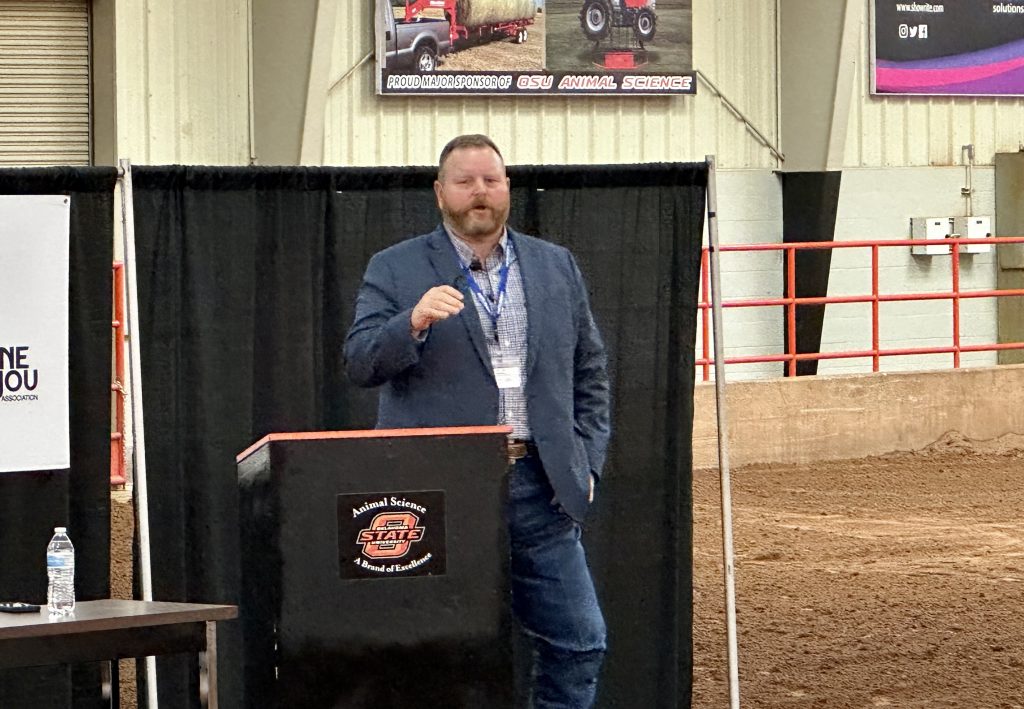
At this year’s Cattlemen’s Conference, Blueprint for the Future, Radio Oklahoma Ag Network Intern, Maci Carter, had the chance to visit with Dr. Jeff Goodwin of Texas A&M about enhancing the soil health of grazing lands.
Soil health, said Goodwin, is really about understanding the soil’s capacity to continue functioning, support, and work as a living ecosystem.
Goodwin shared that soil is much more than just a medium for our crops or grasses; it is a living ecosystem. The health of these ecosystems plays a vital role in the productivity of the soil.
“From a soil health perspective, it really is sort of pinned on our ability to sequester or increase the accumulation of organic matter in our soils,” Goodwin said. “As we start to build and repair these ecological processes, we start to see the sort of core four ecosystem processes start to get better. They also provide sort of these feedback loops that really help the ecosystem function at its best pace.”
Goodwin said increasing organic matter is the best way to make soils more resilient. He added that the increase raises infiltration capabilities, increases drought resilience, and it repairs some of the ecological processes, which will provide feedback and continue to improve the ecosystem’s productivity.
“We can see how much we’re grazing, and how much we’re utilizing a pasture,” Goodwin said. “What we can’t see are the exudates, the sugars, starches, and carbohydrates that are being released and feeding the biology underground. But we see increased productivity, and increased diversity when we start to manage based on these soil health principles. All those things are representative of functional rangeland systems. And so we’re just trying to kind of mimic that on these other land uses.”
Goodwin explained that the four ecological processes that impact soil health mostly take place where we can’t see them. However, taking sustainable practices and mimicking the rangeland systems that have been in place for years can give proven benefits.
“We can’t control the depth of the soil, the topography, or the type or kind of texture that you have. But we can control our land cover. We can control the management that we apply to the land.” Goodwin said. “Context truly drives the situation. Not only does the strategy have to fit the landscape, it has to fit the livestock and the cattle that you’re managing, but it has to fit the rancher, the manager on the land. If it doesn’t fit all three, it’s probably not going to work.”
Goodwin explained that context is everything when planning soil health practices in any given area. There is a lot of context out of anyone’s control, such as topography, weather, economic positions, etc. However, the approach can be controlled. Finding something that meets all the different context areas for any given situation will impact its effectiveness.
At the end of the day, Goodwin said, profitability is key. If we don’t position our producers to be in a profitable position first, the stewardship, most of the time, doesn’t follow.
“Getting that sort of foundational component set up within the ranching enterprise and ensuring that we’re moving towards a profitable position by reducing our inputs and, you know, spreading our fixed costs,” Goodwin said. “All of those things matter from a profitability perspective, and we have to balance or optimize profitability and sustainability.”
Goodwin explained that profitability is a huge priority, however, soil health is also a tool to increase profitability. He said soil health could be the key to quick recovery and resilience to hardship and can help ranchers move towards a more profitable position in many ways, as long as profitability and sustainability can be balanced.
“Go dig a hole, you know, go look,” Goodwin said. “Observation is a key driver in what we do, and take a look at and develop some baselines. Take some soil samples. Get with somebody that understands what they’re doing. Ask those questions. Keep asking questions. We can still have positive ecological returns by balancing stocking rates and monitoring our timing, intensity, frequency, and duration. Those four things can help us provide the rest and recovery that really drives the success in a grazing system.”
The advice that Dr. Goodwin has for anyone hoping to get their start in more sustainable grazing practices is to observe what you have, get data to back it, and not stop asking questions. Not every issue requires the same solution, so take a step back and consider the timing, intensity, frequency, and duration when making management decisions.














